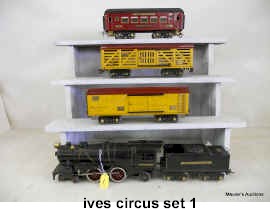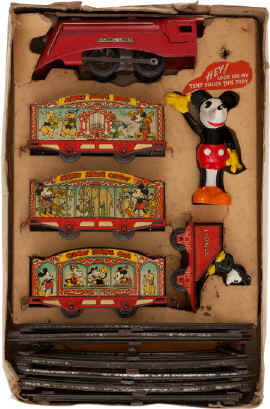|
Model Trains
By Jeff Figler
Many people are familiar with the saying that
"the difference between men and boys is the cost of their
toys." That is probably a very true statement.
In fact, I am a model train collector, and I admire
other peoplesí train sets when I have the opportunity to see them.
Believe me, some toy trains can be very expensive, and others are more
reasonable. However, how much a person spends on their model trains, and
how elaborate they want it to be, will largely depend on, literally, how
many bells and whistles they want their toys to have.
 But even though you see toy and model trains now
across the world, and of course, a company such as Lionel is universally
known, it is interesting to know how the hobby started. Collectors have
been interested as well. But even though you see toy and model trains now
across the world, and of course, a company such as Lionel is universally
known, it is interesting to know how the hobby started. Collectors have
been interested as well.
Well, there have actually been model trains for as
long as there have been railways, as some of the early locomotive models
were made as promotional tools for the early trains. Of course, they
were not as sophisticated as todayís models, but they served their
purpose.
In Europe, in the Victorian period, there were model
trains that were not only for the commoner but for the wealthy and
royalty as well. Ironically, the trains were mostly made in Germany.
However, the watershed event in model train history
was in 1891 when Marklin developed a complete system of trains. Marklin
introduced a series of standard track gauges. The new system allowed
model train collectors flexibility to build sets. Markets in various
countries were also established.
 In the United States electric trains were being
devised, and from the late 1890s, they were available to the model train
fan. In fact, the U.S. manufacturers Ives and Lionel clashed before
Lionel and American Flyer became the dominant U.S. manufacturers,
especially from the 1920s forward. The Marx Company also had a share of
the market. In the United States electric trains were being
devised, and from the late 1890s, they were available to the model train
fan. In fact, the U.S. manufacturers Ives and Lionel clashed before
Lionel and American Flyer became the dominant U.S. manufacturers,
especially from the 1920s forward. The Marx Company also had a share of
the market.
The popularity of model trains was high in the 1920s
and 1930s. There were now modelersí magazines, which emphasized home
construction and ways to improve your train layout no matter what gauge
train you had. In the United States, Lionel train sets were given as
gifts. Some of these packaged sets have been passed down from one
generation to another. They are worth thousands of dollars if they are
in good running condition and if the original box is still in good
shape. Of course, companies such as Lionel emphasized that model train
collecting was a family hobby, and that people of all ages can enjoy it.
Model railroading was popular, especially with HO
scale trains, although smaller gauges often were used in areas that did
not have a lot of room.
 Production slowed during World War II, but surged in
the 1950s, and model trains were mass produced. Production slowed during World War II, but surged in
the 1950s, and model trains were mass produced.
However, as real trains began losing their dominant
transporting role to cars and airplanes, the model trains were losing
popularity as well. Model trains began to lose their appeal to children.
Model trains were mainly for the adults and
collectors. They are still very much alive. The emphasis is on trains
for the adult modeler, as well as on the collector, and for children.
With all the trains that have been produced there are
plenty of opportunities for the collector to enjoy not only vintage
trains from the past but new productions as well. For example, a Lionel
Mickey Mouse circus train set from 1935 sold for nearly $10,000 at a
2014 auction. Not only were train collectors attracted to the set but
Mickey Mouse collectors as well. A very rare Wilkins floor train from
circa 1900 sold for $11,000, while a Hubley elevated railway, a rare
American clockwork toy, sold for $18,000.
American Flyer trains from the late 1920s are always
in demand. One of the sets, the Presidentís Special is expensive, and,
depending of condition, can cost upwards of $20,000 or more. Another
American Flyer set, the Mayflower, is even more rare, but is rarely
available. |